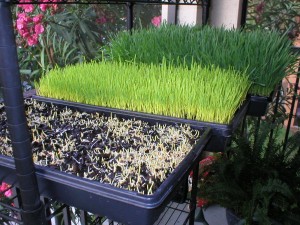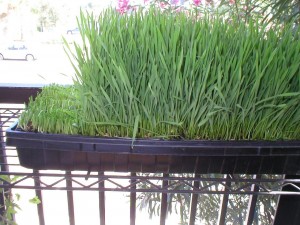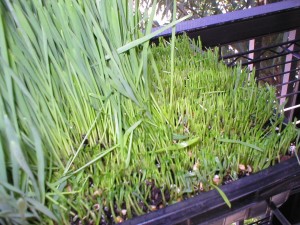How To Grow WheatGrass – Growing Instructions
WheatGrass Health Benefits
Harvesting and Storing Wheatgrass
Juicing and Drinking Wheatgrass
Cleaning Your Wheatgrass Juicer
When to Harvest Wheatgrass?
Pictured below is day seven of wheatgrass growing cycle and time to take your first partial harvest for juicing.
Harvest wheatgrass by cutting just above the top of the soil. It is always best and optimal for nutritional and live enzymes effect to harvest and juice when wheatgrass has been freshly cut. If mold appears rinse your wheatgrass thoroughly before juicing.
Harvesting and Storing Wheatgrass?
Pictured below is day eight of the wheatgrass growing cycle.
At some point in the growth cycle the wheatgrass is at an optimal nutritional juicing point. This point is just before or as the grass starts to split and begins it’s reproductive cycle. This is why I recommend to harvest all the wheatgrass at this point and juice what you need to immediately consume and store the rest in a container in the frig. Harvested or cut wheatgrass placed in a container will last about seven or eight days in a common refrigerator. Do not let harvested wheatgrass freeze and do not eat or juice wheatgrass if it has begun or has turned yellow.
High humidity during the growth cycle may cause mold to grow at the base of your wheatgrass. If mold does appear rinse your wheatgrass thoroughly before juicing or consuming raw wheatgrass.
One Time Growing Cycle for Wheatgrass and Proper Disposal
Wheatgrass is great because the growing cycle is only between seven and fourteen days. The difference in the time growing cycle is due to watering, sunlight, humidity, temperature and soil differences.
Wheatgrass can be grown and harvested only once. Please discard your post harvest growing remains properly. Proper disposal may include compost or mulch it into your outdoor garden. Organic wheatgrass growing remains have a high natural organic make up and will add to the natural value of vegetable garden soil as well as many other types of gardens.




 Click On Above Ad to Go To Website
Click On Above Ad to Go To Website

